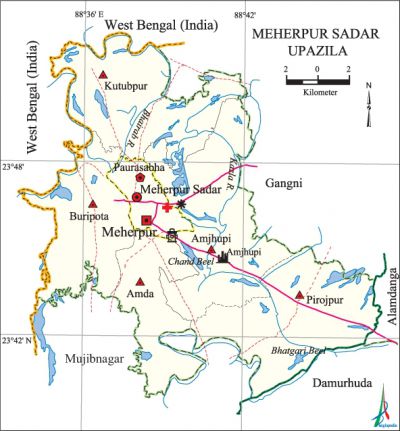Meherpur Sadar Upazila
Meherpur Sadar Upazila (meherpur district) area 261.42 sq km, located in between 23°40' and 23°52' north latitudes and in between 88°34' and 88°47' east longitudes. It is bounded by gangni upazila and west bengal state of India on the north, damurhuda and mujibnagar upazilas on the south, Gangni and alamdanga upazilas on the east, West Bengal state of India on the west.
Population Total 232465; male 119157, female 113308; Muslim 228518, Hindu 3700, Buddhist 149, Christian 15 and others 83.
Water bodies Main rivers: bhairab, Kazla; Bhatgari and Chand beels are notable.
Administration Meherpur Thana was turned into an upazila in 1984. Meherpur Municipality was formed in 1960.
| Upazila | ||||||||
| Municipality | Union | Mouza | Village | Population | Density (per sq km) | Literacy rate (%) | ||
| Urban | Rural | Urban | Rural | |||||
|
1 |
5 |
60 |
104 |
34624 |
197841 |
889 |
61.5 |
34.3 |
| Municipality | ||||||||
|
Area (sq km) |
Ward |
Mahalla |
Population |
Density (per sq km) |
Literacy rate (%) | |||
|
15.18 |
9 |
72 |
34624 |
2281 |
61.5 | |||
| Union | ||||
| Name of union and GO code | Area (acre) | Population | Literacy rate (%) | |
| Male | Female | |||
|
Amjhupi 19 |
15486 |
23662 |
22694 |
37.63 |
|
Amda 14 |
8116 |
13718 |
13501 |
29.60 |
|
Kutubpur 57 |
13556 |
20673 |
19947 |
31.65 |
|
Pirojpur 95 |
13953 |
24190 |
22418 |
33.69 |
|
Buripota 38 |
9920 |
19080 |
17958 |
37.15 |
Source Bangladesh Population Census 2001, Bangladesh Bureau of Statistics.

Archaeological heritage and relics Ballavpur Mission, Swami Nigmand Asram (Kutubpur), Amjhupi Kuthibari (Amjhupi), Mirzapur Dargah, Kalitala Mandir, tomb of Barkat Bibi (Barkondajpara).
Historical events Once the Amjhupi Neelkuthi of the indigo planters was the torture centre. On 18 April 1971 the Pak army killed 8 innocent persons at Amjhupi of Meherpur town.
Marks of the War of Liberation Mass killing site 1 (backyard of Meherpur College).
Religious institutions Mosque 334, temple 7, church 1, tomb 3. Noted religious institutions: Hiru Mollah Mosque (Pirojpur), Bagu Dewan Tomb, Mirzapur Dargah, Meherpur Shiva Mandir (Meherpur), Samadghi Mandir of Balaramhari at Malopara, Bhabanandapur Mandir (Amda), Kalitala Mandir, Alampur Shympur Mandir.
Literacy rate and educational institutions Average literacy 34.4%; male 40.8%, female 35.9%. Educational institutions: college 3, secondary school 16, technical institute 2, primary school 63, madrasa 6. Noted educational institutions: Meherpur Government College (1962), Meherpur Government Mohila College (1984), Meherpur Government Boys' High School (1854), Meherpur Model High School (1859), Meherpur Government Girls' School (1940).
Newspapers and periodicals Daily: Azam; weekly: Parichay (1985), Chumbak (1986); defunct: weekly: Mujibnagar (1988),' Meherpur (1992); fortnightly: Pashimanchal; monthly: Sadhak (1913), Palli Shree (1935), Simanta (1962), Probaha (1979); periodical: Basumati, Nandankanan; bulletin:' Raktashaskhar (irregular), Agami (irregular).
Cultural organisations Library 4, club 15, shilpakala academy 1, shishu' academy 1,' theatre stage 2, theatre group 15, cinema hall 4, playground 8.
Tourists spots Amjhupi Kuthibari, Swami Nigmand Ashram.
Main sources of income Agriculture 65.80%, non-agricultural labourer 4.08%, industry 0.76%, commerce 14.21%, transport and communication 2.88%, service 5.08%, construction 1.15%, religious service 0.17%, rent and remittance 0.66% and others 5.21%.
Ownership of agricultural land Landowner 56.64%, landless 43.36%; agricultural landowner: urban 40.20% and rural 59.35%.'
Main crops Paddy, wheat, maize, jute, sugarcane, tobacco, betel leaf, onion, garlic, vegetables.
Extinct or nearly extinct crops Sesame, mustard, barely, kaun, linseed, arahar, gram.
Main fruits Mango, jackfruit, litchi, banana.
Fisheries, dairies and poultries Fishery 16, dairy 10, poultry 23, hatchery 1.
Communication facilities Pucca road 184 km, mud road 400.
Extinct or nearly extinct traditional transport Palanquin, bullock cart.
Noted manufactories Flour mill, ice factory.
Cottage industries Blacksmith, weaving, potteries, embroidery, bamboo work, wood work.
Hats, bazars and fairs Hats and bazars are 16, most noted of which are Amjhupi Hat, Baradi Hat, Shalika Hat, Shympur Hat, Tengramari Hat and Baliarpur Hat.
Main exports Betel leaf, onion, garlic, banana, sugarcane molasses, mango, litchi, jackfruit.
Access to electricity All the wards and unions of the upazila are under rural electrification net-work. However 31.61% of the dwelling households have access to electricity.
Sources of drinking water Tube-well 90.16%, tap 3.77%, pond 0.23% and others 5.84%. The presence of arsenic has been detected in 11.37% of the shallow tube-well water of the upazila.
Sanitation 21.11% (rural 14.99% and urban 58.28%) of dwelling households of the upazila use sanitary latrines and 47.68% (rural 49.62% and urban 35.87%) of dwelling households use non-sanitary latrines; 31.21% of households do not have latrine facilities.
Health centres Hospital 3, satellite and family welfare centre 4, clinic 5.
NGO activities Operationally important NGOs are asa, brac, caritas, Nari Unnayan Shakti, Nari Mukti. [Gazi Rahman]
References Bangladesh Population Census 2001, Bangladesh Bureau of Statistics; Cultural survey report of Meherpur Upazila 2007.
